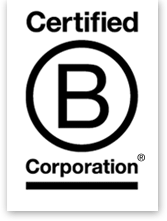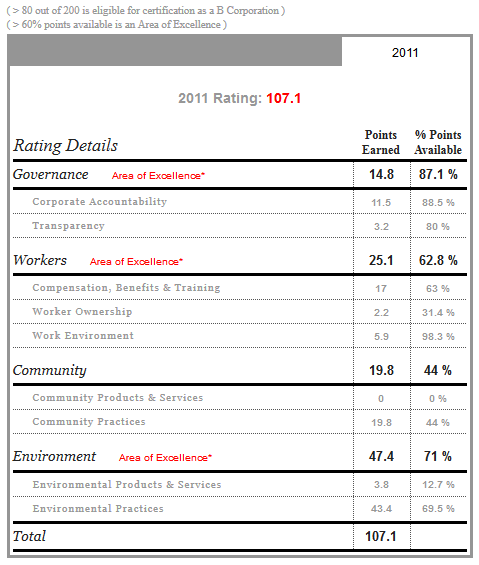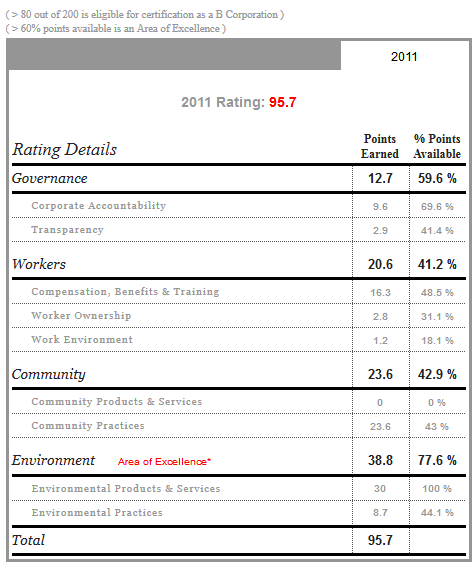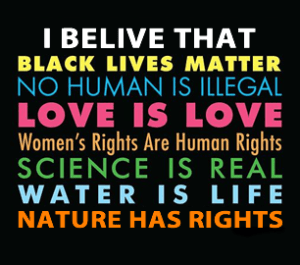The B Corporation – Hype or Hope?
 So I was recently asked to share some thoughts on the rise of the B Corporation–or benefit corporation–and their role in relation both to Occupy Wall Street and possible shifts in economic thinking and ideas more generally. What follows is a quick first pass to answer these questions.
So I was recently asked to share some thoughts on the rise of the B Corporation–or benefit corporation–and their role in relation both to Occupy Wall Street and possible shifts in economic thinking and ideas more generally. What follows is a quick first pass to answer these questions.
In a nutshell, a B corporation is a fairly new classification which is for businesses which are for profit, but have a primary interest in providing social and environmental goods through their business operations, as opposed to a purely bottom-line profit incentive of a traditional corporation. In essence, think of it as a hybrid between do-gooder non-profits and green capitalism with an emphasis on social, environmental and governance issues–what are commonly referred to in the socially responsible investing world as “SEG criteria.” The idea is that B corporations are creating a new business climate that does not prioritizes profit over doing good, but rather highlights companies that are both responsible and profitable.
I won’t go into the history of the B corp here, but you can learn more about the ideas behind B corps and their founders–the non-profit B Lab–here. In short, it was founded by some folks who thought that non-profits were too limited in their impact, but there wasn’t a good model for a responsible business, so they just made one up. As described on the B Corporation website, B corps are “a new class of corporation that are required to create a material positive impact on society and the environment and to meet higher standards of accountability and transparency.”
At a first glance, the biggest drawback to B corporations, in terms of trying to assess their impacts and influence, is the sheer lack of their existence. Everything started with Maryland adopting the first laws back in April of 2010. Last year California and New York decided to get in on the act, with NY Assembly Speaker Sheldon Silver introducing assembly bill (A4692-A), which made the B corporation officially legal here in New York in 2011. But currently only 7 of the 50 states have passed B corporation legislation. So even including large states like New York and California, this is still just a drop in the bucket. The impact of even these states is effectively non-existent in the bigger economic picture.
For example, there are approximately 517 businesses currently registered as B corporations, according to the B corp website. In contrast, there are 5,767,306 firms registered in the US as of 2011, according to the Bureau of Labor Statistics. I’ll let you do the math, but the point is, the B corps are a statistical anomaly–at best–in terms of actual economics. According to their own data, the B corp impacts to date are “$2.9 Billion in Revenues – 60 Industries – $2 million in Annual Savings.” So while this is encouraging, it’s still small potatoes, which is part of the problem, but given that the B corporation legal status is only about 2 years old, it’s not entirely fair to say they are not having any impact. After all, how many new ventures can claim to have this kind of impact in only 2 years? So in a sense, they are making a visible impact in the market–both in terms of goods and of new ideas.
But the deeper problem with B corps is that, like many of these “green business” efforts, they suffer from two critical and insurmountable flaws. The first is structural to our thinking about markets, the second is structural to modern economic markets themselves. I’ll walk through both of these to show why I’m not going to hold my breath for the B corporation, or any so-called “sustainable” business movement, to offer any real, meaningful change.
Flaw I: Green Smoke and Mirrors
It didn’t take me too long to run into the most obvious and important flaw, which is how companies get certified and tracked as a B corporation. B Lab developed this assessment tool which companies can take to see if the “qualify” for B certification, and if so, then they can apply for incorporation or re-designation as a B corporation. The problem is, in the certification process, companies only have to score 80 points out of a possible 200 during the initial assessment, which in my mind, makes it essentially worthless. If a benchmark says you are doing a good job by only meeting 40% of the target, and that is enough to get you in the door with a positive ranking, than that is not much of a standard in my mind. Here’s the language from the B corp website:
The first step in becoming a Certified B Corporation is taking the B Impact Assessment, which assesses the overall impact of your company on its stakeholders. The assessment varies depending on the company’s size (number of employees) and sector. Completing the assessment typically takes 60 to 90 minutes. Once you’ve completed the assessment, you will receive a B Report that contains an overall score. If that score is above 80 (out of 200 points available), you are ready for Step 2.
Once you meet this initial benchmark, you have a phone interview (aka an ‘Assessment Review’) with the B Lab folks, and explain why you’re a great company that should be certified. If the interview goes well, you get a final assessment in which they “randomly select 8-10 heavily weighted questions and ask the company to demonstrate those social and environmental practices in more detail through documentation.”Assuming you can pass this final stage–I was unable to find out how rigorous this process, or even what criteria is used to make evaluations, since it is all internal B Lab business–you get the go-ahead to start your B corp paperwork.
Ok, so if we can’t evaluate this process transparently from the outside, we can at least look at who is getting certified. If we jump on over to their certified B companies page, things don’t get a lot more encouraging. The most glaring problem is with the companies themselves–about 85% of those listed on the homepage are all information services, not actual production, manufacturing or similar companies. In other words, it’s really easy to be a “green” company when you don’t make anything and 90% of your operations are online or digital services. A perfect example is PictureHealing, which according to their profile, “develops community, awareness, and support for charity through photo-sharing on your iPhone & Android.”
While this might be a useful business–although I have my doubts–if this is a poster child for the B corp, it has no future as a serious movement. Luckily, there are at least a few more encouraging companies involved in this movement, like outdoor gear giant Patagonia. For anyone unfamiliar, Patagonia is one of the staples of the outdoor apparel industry, and a common brand sported by many in the environmental community. This is partly due to the company donating 1% of their proceeds to non-profits working on environmental conservation, and also because they do cool thinks like make fluffy polyester fleece pullovers out of recycled plastic soda bottles, or what they call their PCR line.
They have also done a good job of marketing the idea of sustainability and environmental conservation as part of their consumer message, which although hypocritical as far as their existence is based on continued conspicuous consumption (and with prices that are far from affordable for the average working class consumer), they are certainly operating from a different ideological framework when compared to competitors like North Face. But part of the reason this is possible is that Patagonia is a privately-owned company not subject to the whims of market investors or shareholders, a seemingly minor yet quite important distinction.
In comparison, North Face is owned by V.F. Corporation, which is traded publicly (NYSE: VFC), and the largest outdoor retailer in the world. V.F. Corp took part in an industry effort in 2000 to create a “corporate responsibility” monitoring system known as the Worldwide Responsible Accredited Program or WRAP, a perhaps questionable effort at industry controlled but seemingly “independent” monitoring of things like labor standards and workplace democracy. You can read a review of these independent certification approaches here for those interested.
A final example is Urban Grid Solar, an actual energy sector industry that specializes in solar installation, wind turbines and electric recharge station construction, design and installation, according to their profile. This is certainly far closer to a traditional energy sector company, and along with Patagonia, points to the potential viability of the B corp for serious economic development, unlike something like PictureHealing.
The problem with all of these examples, however, is that even the more promising companies with real impacts on the economy barely rank above 50% in the B corp rating system. In the two charts pictured here, Patagonia earned a 107% rating, while Urban Grid Solar got a 95.7%. So even the potential poster children like these companies are only meeting about half of the identified benchmarks. Which leaves one to wonder, is there something deeper going on in this story if a solar energy company or an outdoor gear story with an underlying environmental ethic struggle to even meet a 50% benchmark? I think the answer is yes, there is something deeper at work–it’s called capitalism.
Flaw II: Capitalism
The deeper problem gets at the root of this question about B corporations, socially responsible investing and the so-called free market. In the most simplistic sense, all of these efforts are doomed to fail under our current industrial production system because the very model of our modern industrial civilization is unsustainable from start to finish. And since the global world market is based, first and foremost, on the underlying energy infrastructure, as long as this underlying system has no future, nothing built on this same system can overcome this critical flaw. No matter how “green” your business is, if it relies on an industrial infrastructure for its continued operation, it has no future. And that’s the problem with the whole of the socially responsible investment movement–it is based on a fundamental flaw in thinking–namely there is such a thing as a friendlier and less destructive form of industrial capitalism. The sad truth is, there isn’t, and never will be.
This is one area where even the Occupy movement has dropped the ball. But perhaps blaming the occupy movement is a red herring, as even most people involved with the occupy movement are still operating within a liberal capitalist mentality–what we like to call “progressive” politics on the left–but which truth be told is just an illusory attempt to fool ourselves into a false optimism by ignoring the underlying structural reality of our modern world. It’s also one of the reasons the Occupy movement, for all of its critique of capitalism, is not a real threat to the politics as economics as business as usual–even most folks I know involved with occupy are not anti-capitalist, they are just against short-term economics that put people over profits. Hidden behind this critique, however, is an unwavering faith in modernity, progress and technology to make things better.
Until folks on the left–and right–and middle, start to understand that the problem is not capitalism, or a little better set of business ethics, but rather the entire underlying energetic structure that supports everything we do in modern, industrial nations, all of this talk of sustainability and responsible B business, is all a lot of hot air. Don’t believe me, just look at Obama’s latest stump speeches on the road this month, where he is touting new oil and gas exploration in the Gulf of Mexico as a solution to our economic, domestic energy and security woes.
Until we get serious and start talking about building an economic system that is locally based, cooperative and barter friendly, we might as well stop wasting out time talking about “real alternatives,” because none of this green investing will ever make a real difference, no matter how big the Occupy movement or the socially responsible investing community grows. The sooner we wake up to this reality, the sooner we can start talking about real economic alternatives, instead of wasting our time pretending we can spend our way into a solution.
Until next time…
###




